White irises: varieties and cultivation
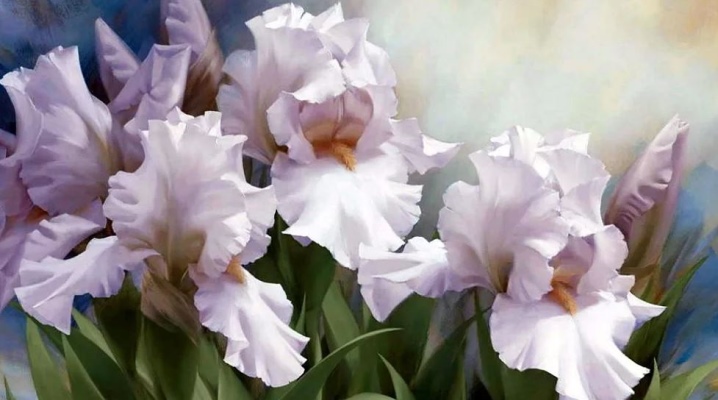
Irises can be seen in almost any flowerbed near the house. Everything is attractive in them - the shape of the flower, the aroma and even the greenery, which retains its fresh appearance for a long time after flowering. Besides beauty, they also have cultural significance. These flowers are mentioned in various literary works and are symbols of honor and power. White color also has its own meaning and is universal, which is why such irises are often used to decorate public architectural objects or parks. All this makes you admire irises and appreciate their beauty.
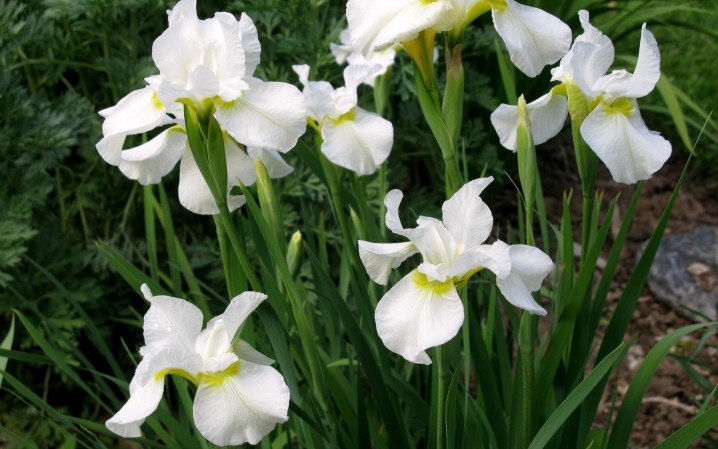
Peculiarities
Irises are perennial herbaceous plants with a strong rhizome. The leaves grow in a bundle from the base and have a xiphoid shape (less often linear). On a strong peduncle there is one large and fragrant flower or a small inflorescence. The beauty of flowers is due to a special structure: the outer petals are slightly bent down, while the inner ones, on the contrary, are raised up. The flower petals stand out for their bizarre shape and color. In addition to snow-white irises, you can find amazing combinations of white with yellow, coral, blue and their various shades. Some species additionally have colored beard hairs that add charm to the flowers. These extraordinary flowers are somewhat similar to orchids.

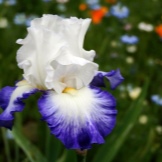
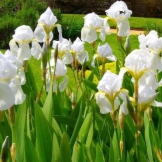
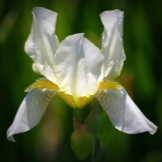
In natural conditions, irises can be seen in different parts of the world, there are varieties adapted to completely different weather conditions - they are found both on arid hills and along the banks of water bodies. Most hybrids are quite unpretentious and winter-hardy. They can even be grown at home - in containers, providing suitable conditions.
Varieties
It is not easy to understand the variety of irises, therefore, before making the final choice and purchasing planting material, you should familiarize yourself with the characteristics of a particular variety. They can vary in flowering time - from late spring to the second half of summer. In addition, in the world classification, one can find a division into rhizome and bulbous, but in the Russian community, the latter do not belong to irises. Rhizomes, in turn, are divided into bearded and beardless. You can find dwarf varieties, medium-sized and tall.
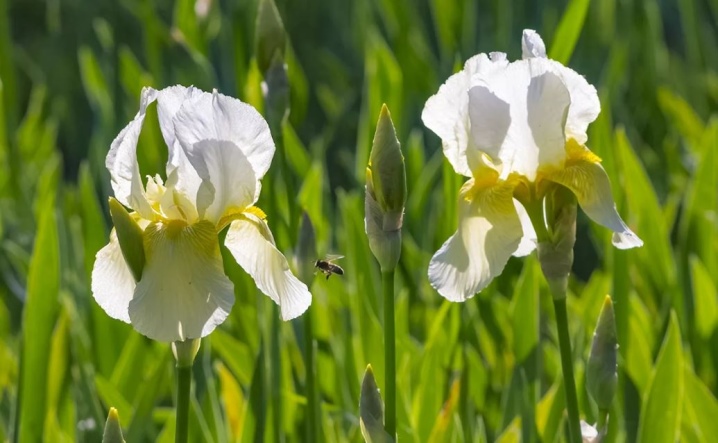
Irises with pure white petals are very rare. The most common varieties with colored inclusions. Moreover, many flower growers value them precisely for this and consider them more interesting, because any shade on a white background seems especially bright. The following variety names can be cited as examples:
- Immortality - a variety with delicate flowers and light yellow inclusions in the middle;
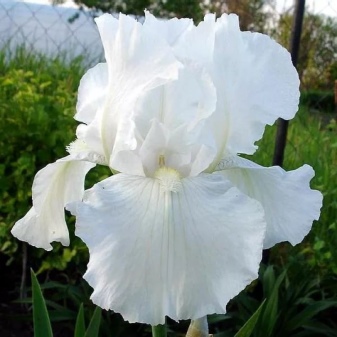
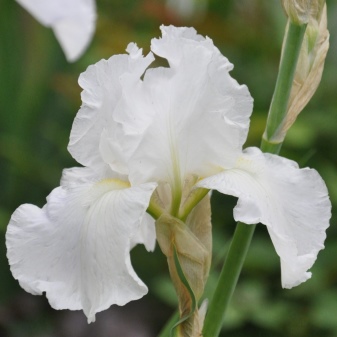
- "Bianca" - Germanic iris with white large flowers and a high peduncle, quite hardy;
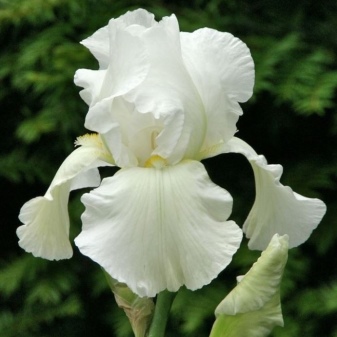
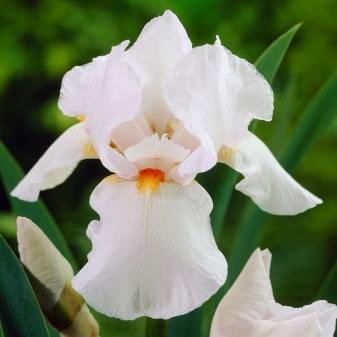
- Nordica - repeated prize-winner of exhibitions, the variety is distinguished by strongly corrugated flowers with white petals and a bright beard;
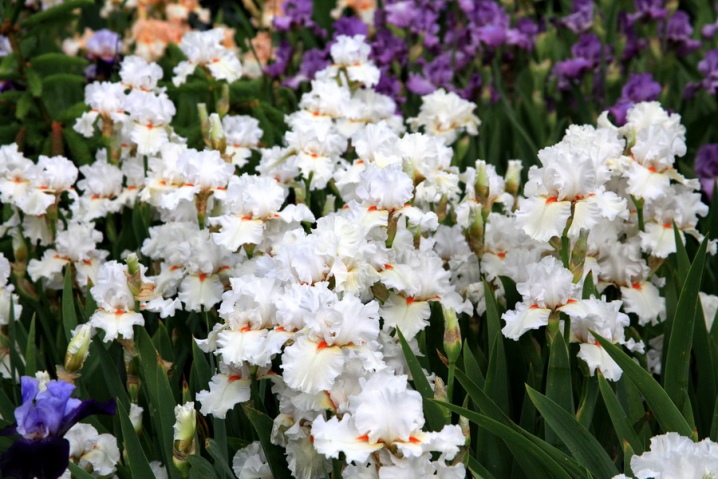
- White ladies - snow-white Japanese irises with yellow or yellow-green bases of open petals;
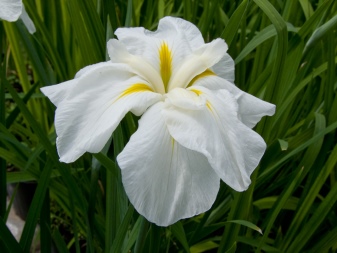
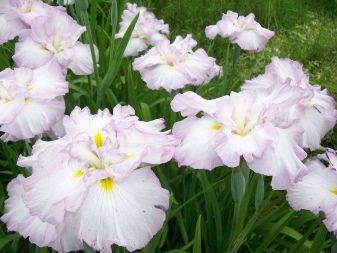
- Queen`s circle - an original variety of bearded irises with a border along the edge of the petals of the lower tier (the color can vary from blue to lilac).


How to plant?
First you need to decide on the timing of planting, since these flowers can be planted at different times. Of course, autumn is best suited for this, since before the onset of cold weather the plant will be able to take root and its chances of a safe winter will increase. If the landing did not have time to be done in the fall, you can postpone it to the spring - April or May, depending on the climate of the region. To make the irises feel more comfortable, you need to choose a place - it should be sunny, without shading.
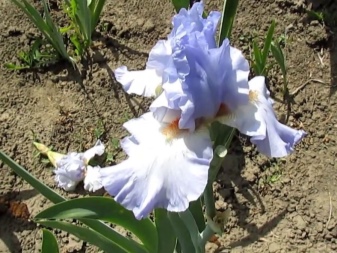
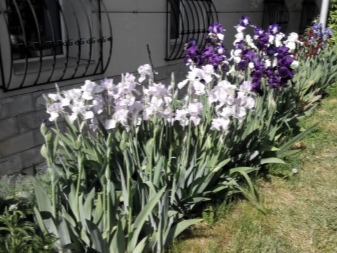
Since the flowers and greenery are quite delicate, the future flower bed should be protected from strong winds.
For planting, you can use both purchased planting material and prepared by yourself. In any case, first, the rhizome must be soaked in potassium permanganate, and at this time you can prepare a flower bed. The selected area must be cleaned, leveled and well dug up. At this stage, good humus and other additives (for example, with potassium and phosphorus) must be added to the soil. With the help of sand or peat, you can adjust the density of the soil, make it lighter.

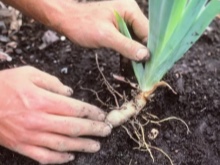

Planting irises is quite simple, just proceed as follows.
- Shallow pits or holes are dug. Sand is poured into the bottom in the form of a mound - it will provide good drainage. You can do without sand, forming an elevation from the ground, but irises do not like stagnant water, which, moreover, can serve as a good environment for the development of diseases.
- The prepared rhizomes are laid out on the sand, the roots are straightened. It is better to place them horizontally.
- The rhizomes of bearded irises need only be lightly sprinkled with soil so that their upper part remains free. Beardless ones should be deepened a little more.
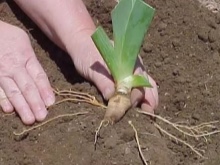
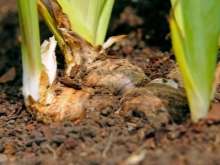
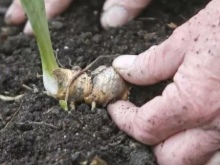
Many people think that since irises are perennials, they should not be replanted. However, after ten years they will begin to bloom worse or stop altogether. The point is that their the root system grows too densely, and the plants do not have enough space and nutrients to develop.
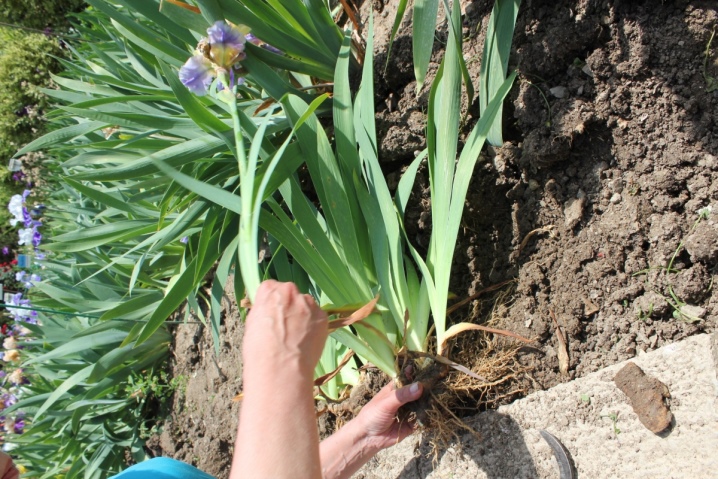
In addition, timely transplantation (on average once every five years) makes it possible to assess the condition of irises and obtain new planting material.
To transplant irises, the following procedures must be followed.
- Wait at least a month after they have faded. Then remove the greens, leaving a small stem.
- Remove the plant with a large lump of soil and gently pick it up with your hands so as not to break the root part.
- The rhizome must be examined, dead roots and damaged areas must be removed, and divided into links.
- If irises need to be planted right now, they do it in the way described above. If they need to be removed for storage, then all the links need to be dried a little in the shade. The seedlings are stored in boxes or ventilated bags, which are placed in a cellar or basement.
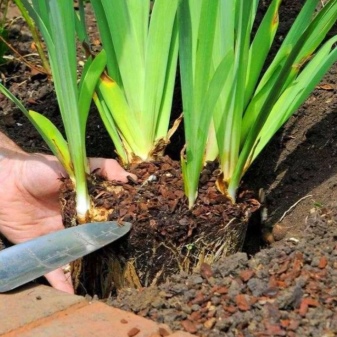
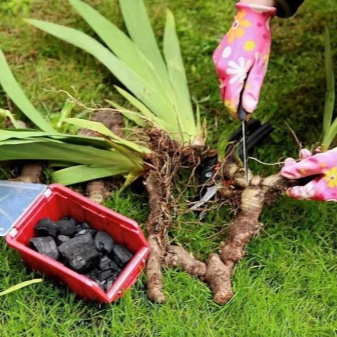
When planting, the distance between the seedlings in the hole must be observed. Depending on the height of the future plant, it can vary from 10 to 30 cm.There should be at least 20 cm between rows or adjacent beds. For the flower bed to look neat, all the aisles must be the same. Since these flowers can move during the growth process, the rhizomes are laid out with a stem along the hole, and not across.
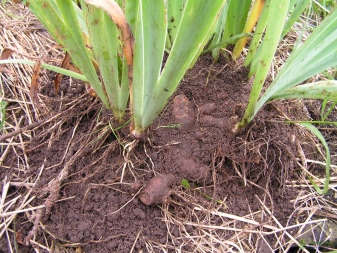
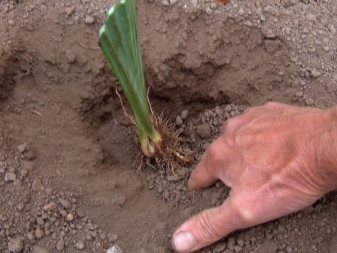
Care rules
After planting do not forget about regular maintenance.
- After the autumn planting, the flowerbed does not need to be watered, but it is advisable to cover it with mulching material. This layer is laid in the form of a mound for better water flow. If a harsh winter is expected, for this period it is covered with straw or spruce branches. In the spring, the removal of insulation and mulch takes place in two stages.
- In spring and summer, irises, like any flowers, need regular watering. This is usually done in the morning or in the evening, directing the stream to the root. During the period of budding and flowering, additional fertilizing can be added to the water. Even if the flowering period is over, the greenery retains the integrity of the flower bed for a long time.
- Periodically planting it is necessary to weed and loosen the soil between the rows to improve air exchange.
- High grades can be tied up. To do this, it is better to install the pegs immediately upon planting - so the root system will definitely not be injured.
- It is better to cut flowers for bouquets at an oblique angle - this way the stem is less prone to decay. You cannot completely remove all the greens - the stems and leaves are needed for the development of the rhizome.
- If the trunk or leaves begin to dry or suspicious spots appear on them, you should pay attention to this. At the onset of the disease, the plant can still be saved, for example, by treating it with fungicides. In extreme cases, diseased irises will have to be removed from the roots in order to save the rest of the flowers.
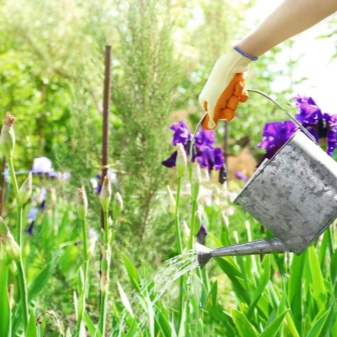
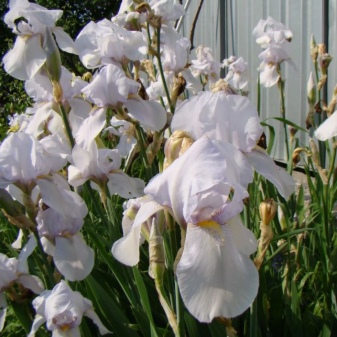
Examples in landscape design
Irises decorate both the territory near private households and public places - parks, squares. To make the composition on the flower bed look the most attractive, you can use the already proven options. Irises are often planted in clusters, alternating their varieties in color and height. In this way, you can arrange paths, hedges, designate garden areas. Often irises become a decoration of water bodies. In this case, it is important not to forget about other details - decorative stones, slides, fences.
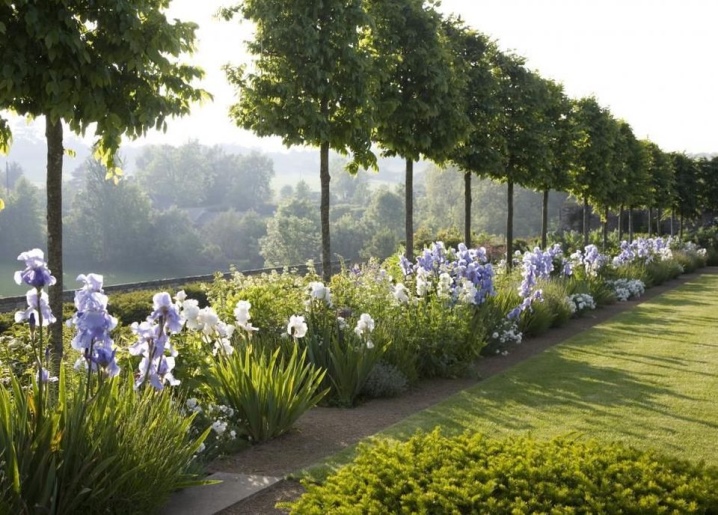
Usually tall irises are placed in the center. Dwarf varieties or any other flowers of suitable height can be used as the edging of the flower bed.
The color scheme of vegetation must be in harmony. For white irises, you can choose pastel combinations (with yellow or pink), emphasizing the tenderness of these colors. If the garden should delight with a riot of colors, two-color can be placed next to them. Contrasting combinations (for example, white and purple) look no less interesting.

Irises look great on their own, but their beauty can be favorably emphasized by other vegetation. Bright varieties look especially impressive in the company of smaller flowers. Another safe bet is shrubs like juniper or fern. Any flowers will look bright against the background of dense greenery. To make the flower bed look elegant at any time, you can plant flowers on it with different flowering periods. When placing, you need to take into account their greenery. Irises are ideal in this regard - they look good even without flowers and can disguise the nondescript foliage of neighbors.
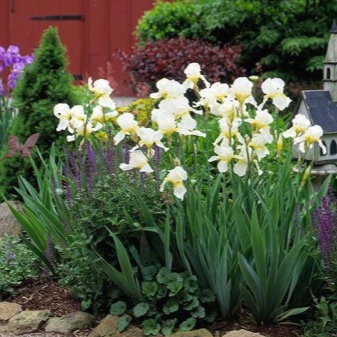
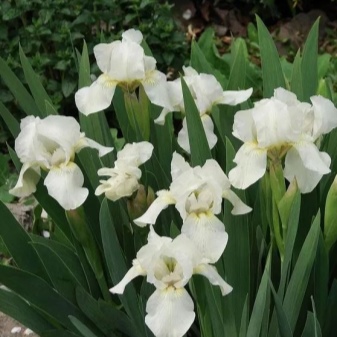
For information on how to properly care for white irises, see the next video.







































































































The comment was sent successfully.